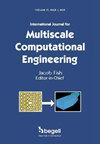Multiscale 3D TransUNet-aided Tumor Segmentation and Multi-Cascaded Model for Lung Cancer Diagnosis System from 3D CT Images with Fused Feature Pool Formation
IF 1.4
4区 工程技术
Q2 ENGINEERING, MULTIDISCIPLINARY
International Journal for Multiscale Computational Engineering
Pub Date : 2024-03-01
DOI:10.1615/intjmultcompeng.2024052181
引用次数: 0
Abstract
A deadly disease that affects people in various countries in the world is Lung Cancer (LC). The rate at which people die due to LC is high because it cannot be detected easily at its initial stage of tumor development. The lives of many people who are affected by LC are assured if it is detected in the initial stage. The diagnosis of LC is possible with conventional Computer-Aided Diagnosis (CAD). The process of diagnosis can be improved by providing the associated evaluation outcomes to the radiologists. Since the results from the process of extraction of features and segmentation of lung nodule are crucial in determining the operation of the traditional CAD system, the results from the CAD system highly depends on these processes. The LC classification from Computed Tomography (CT) images of three dimensions (3D) using a CAD system is the key aspect of this paper. The collection of the 3D-CT images from the standard data source takes place in the first stage. The obtained images are provided as input for the segmentation stage, in which a Multi-scale 3D TransUNet (M-3D-TUNet) is adopted to get the precise segmentation of the LC images. A multi-cascaded model that incorporates Residual Network (ResNet), Visual Geometry Group (VGG)-19, and DenseNet models is utilized to obtain the deep features from the segmented images. The segmented image from the M-3D-TUNet model is given as input to this multi-cascaded network. The features are obtained and fused to form the feature pool. The feature pool features are provided to the Enhanced Long Short Term Memory with Attention Mechanism (ELSTM-AM) for classification of the LC. The ELSTM-AM classifies the images as normal or healthy融合特征池形成的三维 CT 图像的多尺度三维 TransUNet 辅助肿瘤分割和肺癌诊断系统的多级联模型
肺癌是影响世界各国人民的一种致命疾病。肺癌的致死率很高,因为它在肿瘤发展初期不容易被发现。如果能在初期阶段发现肺癌,就能确保许多肺癌患者的生命安全。传统的计算机辅助诊断(CAD)可以诊断 LC。通过向放射科医生提供相关的评估结果,可以改善诊断过程。由于肺结节特征提取和分割过程的结果对传统计算机辅助诊断系统的运行至关重要,因此计算机辅助诊断系统的结果在很大程度上取决于这些过程。利用 CAD 系统从三维计算机断层扫描(CT)图像中进行 LC 分类是本文的主要内容。第一阶段是从标准数据源收集三维 CT 图像。获得的图像将作为分割阶段的输入,其中采用了多尺度 3D TransUNet (M-3D-TUNet),以获得 LC 图像的精确分割。一个包含残差网络 (ResNet)、视觉几何组 (VGG)-19 和 DenseNet 模型的多级联模型被用来从分割图像中获取深度特征。来自 M-3D-TUNet 模型的分割图像是该多级联网络的输入。获得的特征融合后形成特征池。特征池的特征将提供给带有注意力机制的增强型长短期记忆(ELSTM-AM),用于对 LC 进行分类。ELSTM-AM 将图像分类为正常或健康图像
本文章由计算机程序翻译,如有差异,请以英文原文为准。
求助全文
约1分钟内获得全文
求助全文
来源期刊
CiteScore
3.40
自引率
14.30%
发文量
44
审稿时长
>12 weeks
期刊介绍:
The aim of the journal is to advance the research and practice in diverse areas of Multiscale Computational Science and Engineering. The journal will publish original papers and educational articles of general value to the field that will bridge the gap between modeling, simulation and design of products based on multiscale principles. The scope of the journal includes papers concerned with bridging of physical scales, ranging from the atomic level to full scale products and problems involving multiple physical processes interacting at multiple spatial and temporal scales. The emerging areas of computational nanotechnology and computational biotechnology and computational energy sciences are of particular interest to the journal. The journal is intended to be of interest and use to researchers and practitioners in academic, governmental and industrial communities.

 求助内容:
求助内容: 应助结果提醒方式:
应助结果提醒方式:


